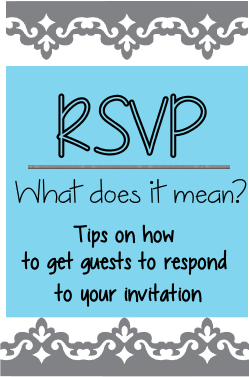

Usually, invitation requesting an RSVP requires the guest to respond within a specified so that the host gets a proper head-count beforehand to make appropriate arrangements for the party. Or you may simply decline the invitation if you are unable to leave them behind. Just check with the host if the total number of guests exceeds the limitation to see if any arrangements can be made to accommodate more guests. The invitation usually has the details of the total number of guests who can accompany. You can also write the number of guests accompanying you in the correct black space. There are also invitations where you can bring in guests along with you which will include a number written like “+1,” and if there is no mention, the invitation is explicitly for you only. Some invitations come with a mention of the people who can accompany you like couples are often referred to as “together,” or at times they can be mentioned as “family” which also includes your children. Most importantly, it is a simple courtesy to let the host know who was nice to invite you even if it is to say that you are not coming with regret. Also, it is recommended not to use these invitations if you panic to know who is coming and end up calling or emailing all your guests. If you are the host, don’t use “RSVP, Regrets only” invitations if you can’t get any refund for guests who have not turned up or if you need an exact headcount to make the party arrangements. You can use other ways to show your enthusiasm to attend the party. If you intend to attend the party, it is better not to reply as it might create confusion. Make sure to respond to the host as instructed if you are not attending. With the term “Regrets only”, you are supposed to inform the host only if you are unable to attend the party because the host expects you to be present. Usually, these are sent out when the location of the party is in a distant place to allow the guests make travel plans or the date of the event to be held quite a considerable time in future.

Some hosts send “Save the Date” cards before sending the RSVP invitations to make the guests aware of the place and date of the celebration. They either come with email addresses where you can respond in writing or use links to any site usually social media where you can choose to accept or decline with the use of buttons. Even if the invitation does not require a reply, consider contacting the planning coordinator to advise of your attendance, remembering to always express your gratitude for the invitation.In this digital age, the use of electronic RSVP invitations has gained its popularity reducing the chances of any responses getting lost in the mail.
/Invitation-GettyImages-128219863-5a3ed6d80d327a0037b2a1f4.jpg)
It is rude and improper for uninvited guests to tag along unless the host specifies “the more the merrier.”Īdhere to the importance of R.S.V.P. On the other hand, do not bring uninvited guests. If an emergency arises, immediately advise the host of your change of plans and share your regrets. Indicating that you will attend means… you will attend. Once a proper response has been made, follow through as stated. When no method is noted, a written letter (reply) is deemed etiquette protocol. If a response card or phone number is included, respond accordingly.

Reply to the invitation by the preferred method of the sender.
Rsvp meaning on invitation how to#
RELATED: Family Reunion Etiquette How to Respond? Hosts: To avoid last-minute responses, include a cutoff date for notifications. If a response date is not indicated on the invitation, at minimum, respond a week in advance. Once you check your calendar, respond! This affords the planner ample time to accommodate guests.ĭo not wait until 2-3 days before the event to respond. Ideally, one should reply upon receipt of an invitation.


 0 kommentar(er)
0 kommentar(er)
